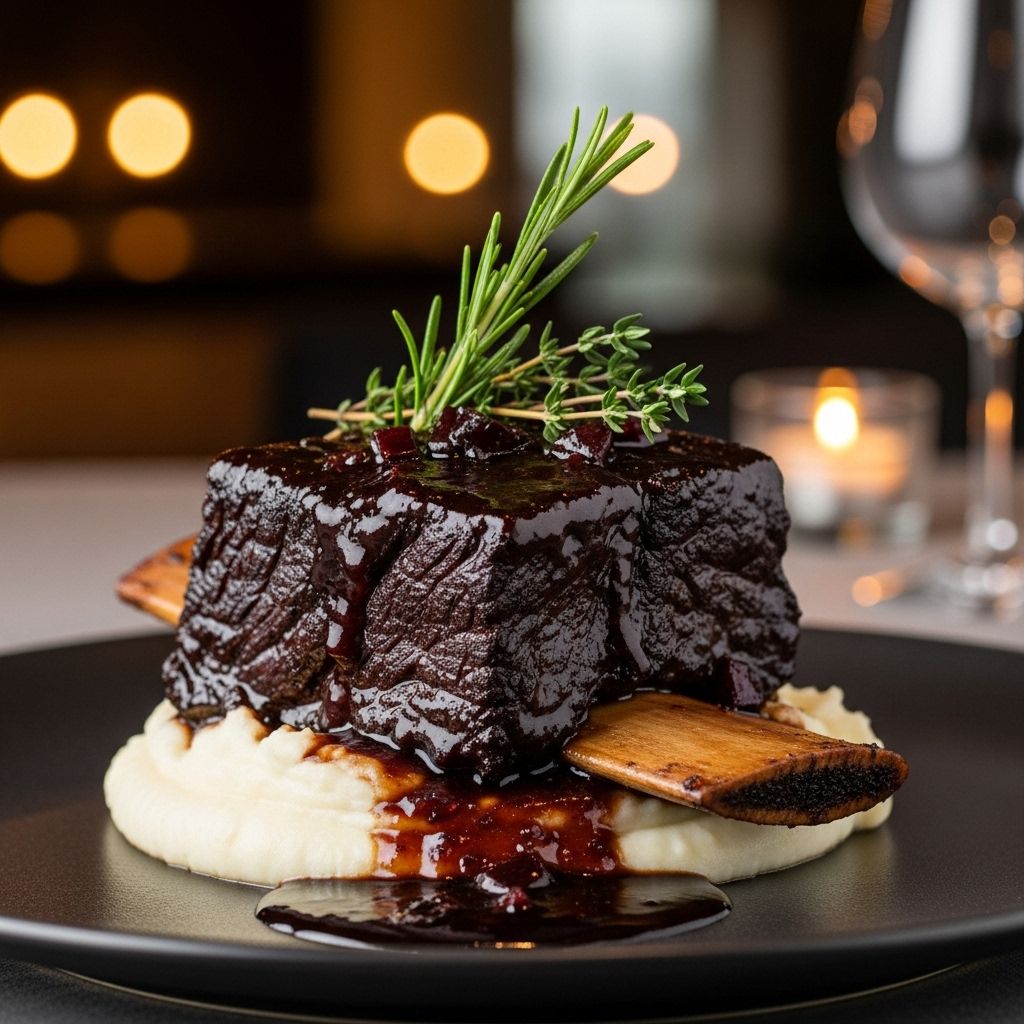Red Wine Braised Beef Short Ribs: The Ultimate Comfort Food Recipe
Experience restaurant-quality depth and succulence in every slow-cooked, silky bite.

If you crave deeply flavorful, fork-tender beef in a rich, silky sauce, nothing compares to red wine-braised beef short ribs. This classic recipe transforms a tough cut into a show-stopping meal through the magical process of slow braising. Here, you’ll find everything you need to master the technique, choose the best ingredients, and present a dish that’s equally at home on a weeknight or a special occasion table.
Why Choose Braised Short Ribs?
Braised short ribs are beloved for their rich, beefy flavor and irresistible, fall-apart texture. The secret lies in the cut itself—well-marbled with fat and connective tissue that, when gently cooked in liquid, melts down to create a succulent and satisfying dish. The combination of seared meat, aromatic vegetables, and an assertive red wine base builds incredible depth of flavor, while the slow cooking ensures incredible tenderness.
- Impressive yet approachable: Suitable for holidays, dinner parties, or decadent weeknight dinners.
- Make-ahead favorite: The flavor improves over time, making this dish perfect for preparing in advance.
- Versatile serving options: Pair with creamy mashed potatoes, polenta, noodles, or crusty bread to soak up the sauce.
Ingredients You’ll Need
For braised short ribs, each component contributes to the final complexity:
| Ingredient | Notes |
|---|---|
| Beef short ribs | Bone-in for maximum flavor; English-cut (thick, meaty) preferred over flanken-cut |
| Salt and black pepper | For seasoning |
| Neutral oil | Canola, grapeseed, or vegetable oil for searing |
| Onion, carrot, celery | The aromatic base (mirepoix) |
| Tomato paste | Intensifies the savory flavor and adds depth |
| Garlic | For pungency and aroma |
| Red wine | Full-bodied varieties (Cabernet Sauvignon, Merlot) work best |
| Beef stock | Richness and body; low sodium recommended |
| Herbs | Thyme, rosemary, bay leaves |
| Optional: Worcestershire sauce | Umami booster, especially as a wine substitute |
Step-by-Step: How to Make Red Wine-Braised Short Ribs
Patience and attention to detail transform basic ingredients into something extraordinary. Here’s a detailed guide to each stage:
1. Select and Prepare the Short Ribs
- Choose meaty, well-marbled short ribs (about 10-14 ounces, bone-in, per person).
- Trim off excess surface fat but leave some for flavor.
- Pat ribs dry and season generously with salt and pepper on all sides for even browning.
2. Sear for Maximum Flavor
- Heat oil in a large Dutch oven or heavy pot over medium-high heat.
- Sear short ribs without crowding until each side is deeply browned, turning as needed. This step develops the foundation of the sauce’s flavor.
- Transfer seared ribs to a plate and pour off excess fat, reserving about 2 tablespoons.
3. Build the Aromatic Base
- Add diced onion, carrot, and celery to the pot. Cook, stirring, until softened and lightly caramelized, about 5–8 minutes.
- Stir in tomato paste and cook for about 2 minutes for a deeper, more concentrated flavor.
- Add minced garlic and cook until fragrant, about 1 minute.
4. Deglaze with Red Wine
- Pour in the red wine and use a sturdy spoon to scrape up the browned bits (fond) from the bottom of the pot.
- Let the wine boil for several minutes to reduce slightly and cook off the alcohol, concentrating the flavors.
5. Return Ribs and Add Braising Liquid
- Nestle the browned short ribs back into the pot with any accumulated juices.
- Add enough beef stock to bring the liquid about three-quarters of the way up the ribs.
- Add thyme, rosemary, bay leaves, and a splash of Worcestershire sauce if desired.
6. Slow Cook to Perfection
- Bring the mixture to a gentle simmer, then cover and transfer to a preheated oven at 300°F (150°C).
- Braise until the ribs are fall-apart tender and the sauce is rich—typically 2.5–3 hours, though thicker ribs may take up to 4 hours.
- Flip the ribs halfway through for even cooking if desired.
7. Finish and Serve
- Transfer ribs to a plate and tent with foil.
- Skim excess fat off the top of the sauce with a spoon or fat separator.
- Simmer sauce to thicken if needed, reducing until it coats the back of a spoon.
- Taste and adjust seasoning with salt, pepper, or a dash of acid (fresh lemon juice or vinegar) to brighten flavors.
- Return ribs to sauce or serve with sauce spooned over top.
Troubleshooting, Expert Tips, and Variations
- Tough ribs? Keep cooking. Connective tissue needs time to melt; if ribs aren’t tender, braise longer and add more stock if necessary.
- Too greasy? Chill sauce to solidify fat for easy removal. Skim after braising for a silkier result.
- No red wine? Substitute with a non-alcoholic wine, or a mix of extra beef stock, water, and a splash of Worcestershire sauce for similar depth.
- Want a smoother sauce? Strain solids from the sauce for a velvety finish. Purée vegetables if desired for more body.
- Make ahead: Braised short ribs taste even better the next day, making them ideal for prepping in advance.
What to Serve with Braised Short Ribs
Complement the succulent ribs and luscious sauce with one or more of these classic sides:
- Creamy mashed potatoes: The gold standard for soaking up sauce.
- Soft polenta: A comforting, earthy base that pairs beautifully with rich sauce.
- Buttered noodles: Egg noodles are a popular European-style accompaniment.
- Crusty bread: For scooping, dunking, and savoring every drop.
- Gremolata: A zesty mix of chopped parsley, lemon zest, and garlic brightens up the dish and offers a fresh counterpoint.
- Roasted root vegetables: Carrots, parsnips, turnips, or other favorites roast well in the oven alongside the ribs.
The Science of Braising: Why It Works
Braising is a technique that uses both dry (searing) and moist (slow simmering in liquid) heat to transform tough cuts of meat into meltingly tender bites. During the long, slow cook, collagen in the beef’s connective tissue breaks down into gelatin, enriching both the meat and the surrounding sauce with an unctuous texture and incredible body.
- Temperature matters: Collagen begins to melt around 160°F (71°C), but complete gelatinization and tenderness is achieved only with more time, often 2.5 to 4 hours at a gentle braise between 275–300°F (135–150°C).
- Flavor layering: Searing, deglazing, and slow simmering each add distinct and critical flavors to the finished dish.
- Alcohol cook-off: Most of the wine’s alcohol evaporates during cooking, intensifying the savory-sweet elements and leaving no “winey” aftertaste—just a deep, complex sauce.
Choosing the Best Wine for Braised Short Ribs
The wine you choose shapes the sauce’s flavor profile. Look for a full-bodied red wine that you would enjoy drinking, but there’s no need to splurge on anything expensive. Budget-friendly bottles deliver excellent results after a long braise.
- Recommended: Cabernet Sauvignon, Merlot, Syrah/Shiraz, Zinfandel
- Avoid: Delicate reds like Pinot Noir, which may get overshadowed
- Tips: Use end-of-bin bargains; the cooking process will concentrate and mellow their flavors
Storage and Make-Ahead Tips
- Refrigerate cooled ribs and sauce in an airtight container for up to 4 days. Some find flavors even better on day two.
- Freeze for longer storage, up to 2 months. Thaw overnight and gently reheat, adding a splash of stock if needed to loosen sauce.
- Reheat: Gently warm covered in a low oven or on the stove over low heat to preserve tenderness.
Frequently Asked Questions (FAQs)
Q: Can I use boneless short ribs for this recipe?
A: Yes, but bone-in short ribs impart more flavor to both the meat and the sauce. Adjust cooking time as boneless may finish sooner.
Q: What if I don’t use wine in my cooking?
A: Substitute with extra beef stock (preferably low sodium), 1 tablespoon Worcestershire sauce, and a dash of water for rich flavor.
Q: My sauce is too thin/too thick. How can I fix it?
A: If too thin, simmer uncovered to reduce. If too thick, add a splash of beef stock or water to reach the desired consistency.
Q: Can I prepare braised short ribs ahead of time?
A: Absolutely! In fact, the flavors deepen and improve after cooling and reheating, making them ideal for make-ahead entertaining.
Q: What pot should I use?
A: A sturdy, heavy-bottomed Dutch oven is perfect for even heat distribution. Any oven-safe pot with a tight lid will work well.
Pro Tips for Perfect Braised Ribs
- Allow ribs to come to room temperature before cooking for even doneness.
- Don’t rush the browning step—this is where you build foundational flavor.
- Taste and adjust as you go, adding herbs or a splash of acid at the end to balance the flavors.
- Try serving with a fresh gremolata for color and brightness.
- Rest meat briefly before serving to help juices redistribute.
Conclusion: Make Braised Short Ribs Your Signature Dish
Discover for yourself the rich rewards of classic red wine-braised beef short ribs. With just a handful of ingredients and the transformative power of a long, slow braise, you can bring restaurant-quality comfort food to your own table, impressing guests or treating yourself to an unforgettable meal.
References
Read full bio of Shinta












